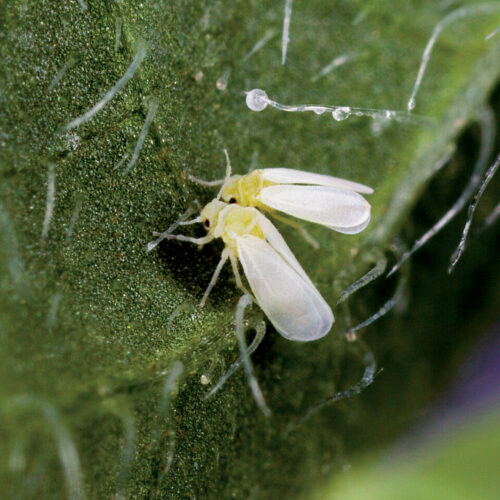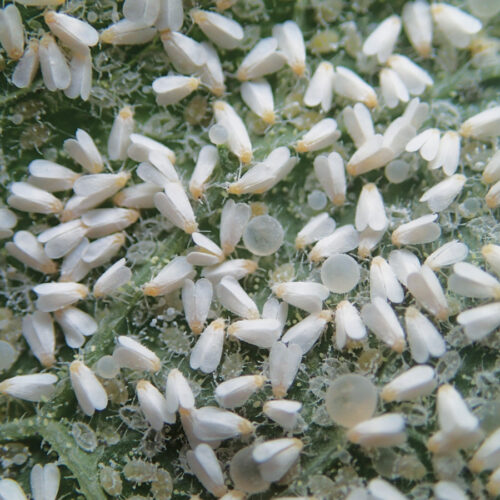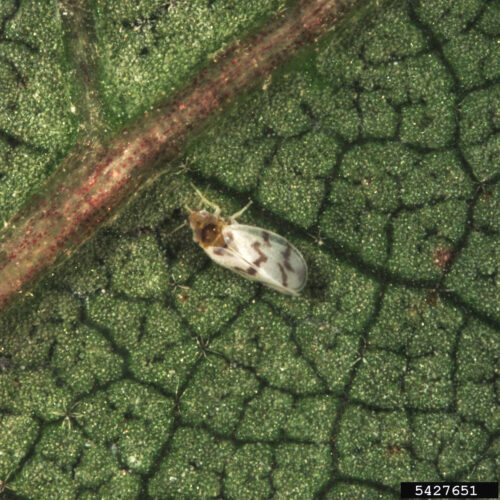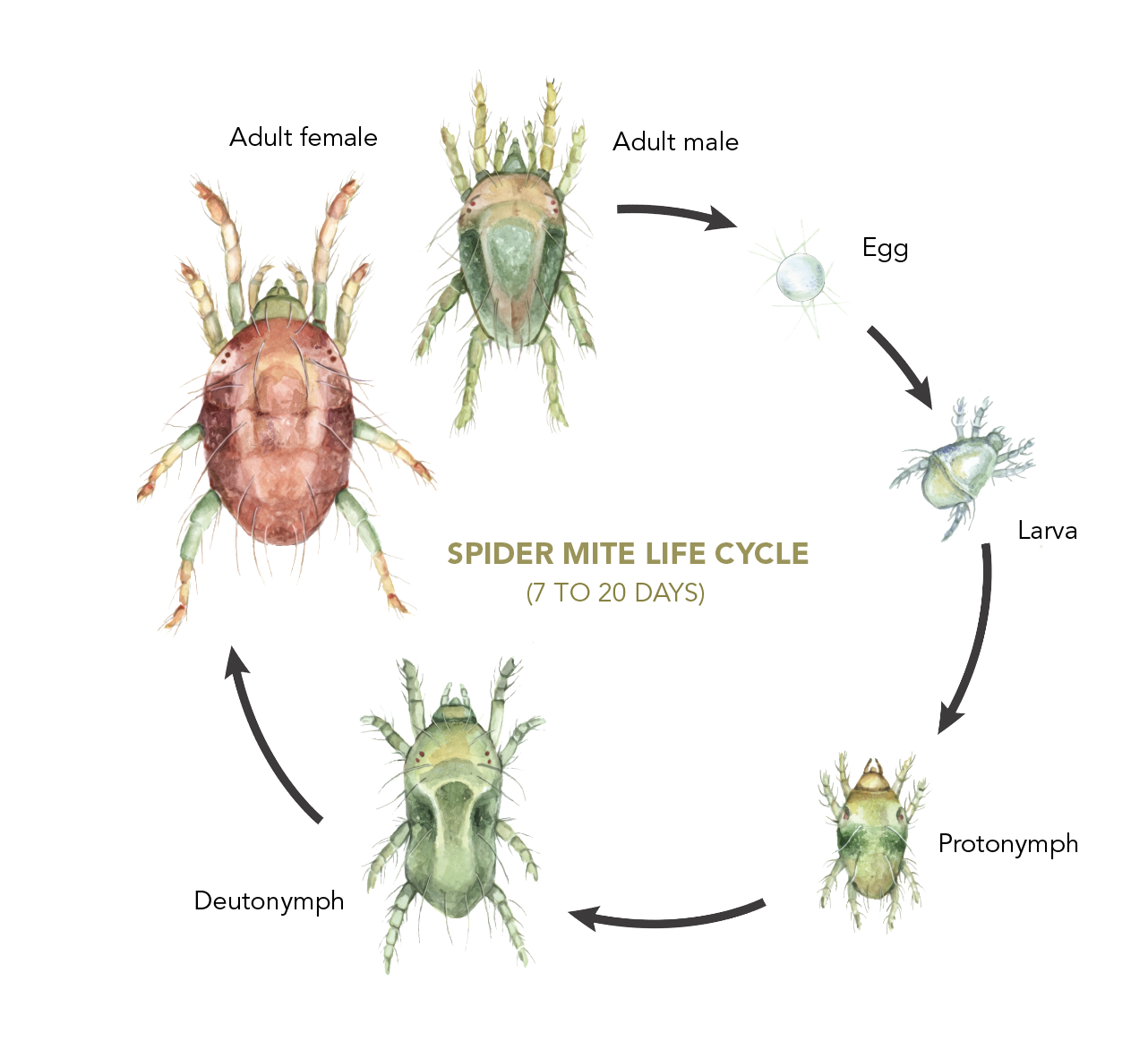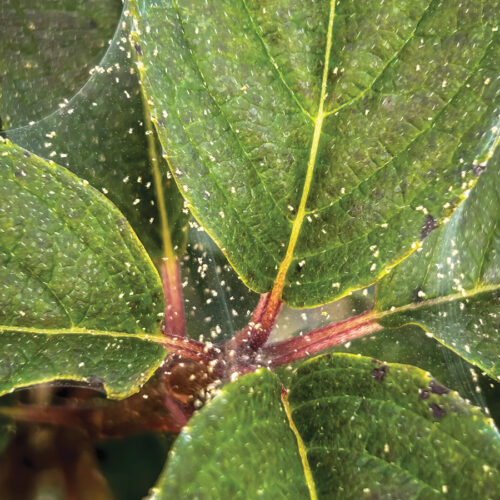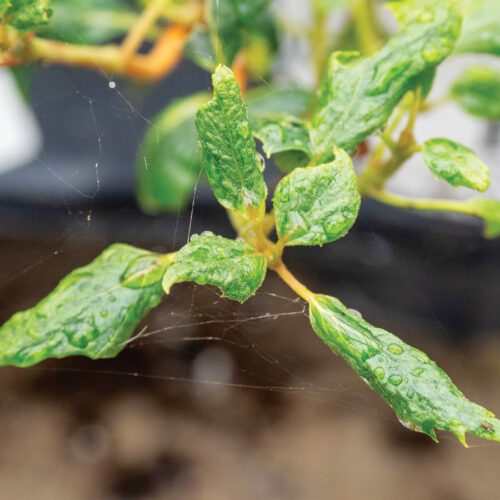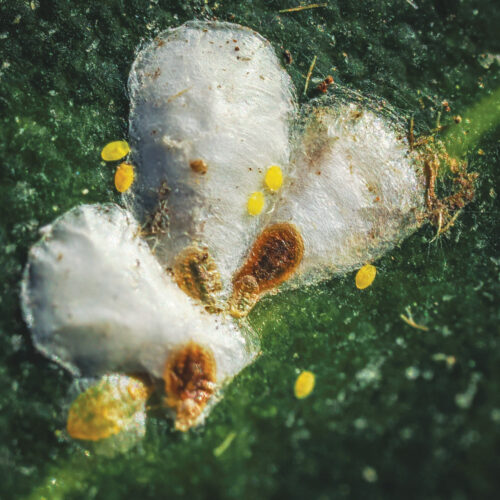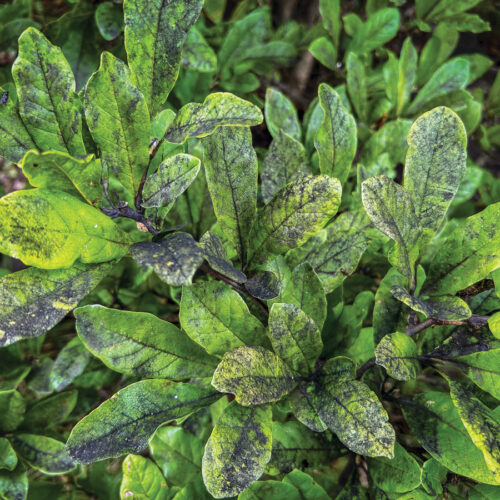As spring shifts into summer, an increase in insect and mite activity often follows. For heat-loving pests like spider mites, broad mites, scales, and whiteflies, regular scouting and early identification will be crucial for successfully managing infestations. Below, you’ll find tips and strategies to reduce summer pest populations and keep your garden looking its best going into fall.
Remember that pesticides kill insects and mites—they don’t heal plants. Prune and remove any damaged or dead branches, and consider culling heavily infested specimens. Keep a close watch the following year, recognizing that preventative applications of pesticides are the best strategy to protect plants from damage. By integrating these management techniques, gardeners can also maintain ecological balance. Always bear in mind that healthy plants are the first defense against pests. Proper watering, fertilization, and pruning will help keep your garden thriving.
Whiteflies: Flighty Virus Vectors
Whiteflies are small (1.6–2.5 mm), sap-sucking “true bugs” that damage ornamental plants by feeding, which causes yellowing and death of leaves. They excrete honeydew, resulting in sooty mold that mars leaf surfaces and interferes with photosynthesis. Whiteflies are also significant vectors of plant viruses. Three common species of whitefly include greenhouse whitefly (Trialeurodes vaporariorum), sweet potato whitefly (Bemisia tabaci), and banded-winged whitefly (Trialeurodes abutiloneus).
Whitefly Management Tips
Start clean. Both greenhouse and sweet potato whitefly are often introduced when new plants are added to the landscape. Inspect new specimens before planting, and consider treating with horticultural oil or neem oil to eliminate hitchhikers.
Monitor regularly. Pay particularly close attention to the undersides of leaves as you look for eggs, nymphs, and adults.
Insecticides should only be used as a last resort. Managing whiteflies with insecticides is challenging because a number of species have developed resistance to the active ingredient in many products. However, horticultural oil and neem oil are reliably effective for knocking down whitefly populations. Numerous insecticides harm beneficial species, worsening outbreaks, so preserving natural predators like ladybugs, lacewings, and minute pirate bugs is a better strategy than widespread insecticide use.
|
Integrated Pest Management (IPM) PRACTICES |
|
Make these earth-friendly habits part of your garden routine: Preserve beneficial insects: Natural enemies like predatory mites, beetles, and parasitoids are vital in controlling pests. Apply the least toxic materials possible: Choose insecticidal soaps, horticultural oils, or sulfur judiciously to reduce harm to nontarget organisms. Monitor regularly: Early detection minimizes the need for chemical interventions. |
Learn more:
All About Integrated Pest Management
Releasing Beneficial Insects for the Garden
Mites: Tiny Arachnid Attackers
Mites are among the smallest arachnids, ranging in size from 1/100 to 3/100 of an inch. Like spiders, most adult mites have four pairs of legs, though larvae often have only three pairs. In addition to their small size, they have a preference for hiding on the undersides of leaves, within buds, and in bark crevices, which makes detection and diagnosis challenging, even with a hand lens.
Spider mites, particularly the two-spotted spider mite (Tetranychus urticae), are notorious for damaging over 180 ornamental plant species. Using needle-sharp, whiplike mouthparts, they pierce leaves to suck sap, causing stippling, yellow spots, and bronzing. Severe infestations lead to leaf drop, and you may notice visible webbing, which protects mites and their eggs from predators. These warm-season mites thrive in the heat of summer, especially during dry spells and droughts.
Spider Mite Management Tips
Start with water sprays. Hose down plants every 3 days to remove mites, webbing, dust, and debris. It may take two to three soaks to get the mite populations under control.
Treat severe infestations with oils or soaps. If spider mite populations haven’t declined by day 12, treat plants with horticultural oil (2% or summer rate), neem oil, insecticidal soap, or sulfur to reduce mite numbers. To minimize plant injury, avoid application when temperatures are high (above 80°F) or when relative humidity is over 90%. Do not use oils on sensitive plants like azalea (Rhododendron cvs., Zones 3–9), hydrangea (Hydrangea spp. and cvs., Zones 3–9), or Japanese holly (Ilex crenata and cvs., Zones 5–9). When in doubt, test the product on a small section and wait 3 to 5 days before treating the entire plant.
Preserve natural enemies. Predatory mites and beneficial insects like spider mite destroyer beetle (Stethorus spp.), mirid (Dicyphus hesperus), and minute pirate bug (Orius spp.) can be valuable allies in mite management. Many common ornamental plant species are useful as “banker plants” that attract and support natural enemies. These include borage (Borago officinalis, Zones 2–11), mullein (Verbascum spp. and cvs., Zones 3–9), ornamental pepper (Capsicum annuum cvs., Zones 9–11), purple coneflower (Echinacea purpurea and cvs., Zones 3–9), and sweet alyssum (Lobularia maritima, annual). Include one to two banker plants per 2,000 to 5,000 square feet to serve as a source of food and protection for natural enemies. Keep in mind that some predatory insects like mirids are omnivorous, and may supplement their diet of mites and insects with plant sap and pollen from garden plants.
Broad mites (Polyphagotarsonemus latus) are even smaller than spider mites, with females measuring just 1/100 of an inch; males are half that size. It’s hard to see them, even with a hand lens, despite the chubby bodies that give them their common name. Unlike spider mites, broad mites tend to thrive under high humidity conditions. Broad mite damage includes stunted growth, deformed leaves and flower buds, bronzing of foliage, and thickened, rugose leaves. Further complicating diagnosis, these symptoms are often mistaken for evidence of herbicide injury, a deficiency of nutrients like zinc or boron, or virus infections. Worst of all, by the time symptoms appear, the mites have often moved on to other hosts. To find broad mites, examine asymptomatic adjacent plants in addition to symptomatic ones.
BROAD MITE Management Tips
Apply horticultural oil, neem oil, or insecticidal soap.
These are effective against active stages but harmful to some natural predators.
Monitor plants regularly to detect early infestations. Also, avoid overuse of chemicals that disrupt natural enemies.
Scale Insects: Stealthy, Armored Sap Suckers
Scale insects, part of the true bug order Hemiptera, feed on leaves and/or branches of ornamental plants, causing discoloration, defoliation, and, in severe infestations, plant death. They fall into two main categories.
Armored scales (Diaspididae) cause yellow leaf spots, leaf drop, and branch dieback. These scales often infest interior leaves, needles, and bark, where they’re shielded from predators. Protected by a detachable waxy coating, armored scales do not produce honeydew. Common armored scale species include pine needle scale, euonymous scale, gloomy scale, and Japanese maple scale.
Soft scales (Coccidae) are enclosed in a waxy coating that is attached to the body, and excrete sticky honeydew. Some common soft scale include oystershell, soft brown scale, magnolia scale, and cottony cushion scale.
Both armored scale and soft scale insects live their adult lives beneath a thick coating composed of waxes and their shed exoskeletons. This coating protects the insect from parasitoids, predators, and pesticides.
All scale insects go through a crawler stage, the most mobile and vulnerable phase of their life cycle. After hatching, crawlers emerge as tiny, active nymphs that move across plant surfaces to find feeding sites. This is the best time to target scale with insecticides or other control measures. Once they settle and begin feeding, they will develop protective waxy coverings.
Scale Management Tips
Target crawlers. Apply horticultural oil after nymphs hatch and before they form their wax armor. If overlapping generations emerge during the season, repeated treatments will be necessary.
Where permissible, carefully apply a systemic pesticide. Neonicotinoids are controversial but, when used appropriately, are less damaging than many other pesticides (including some organic ones). Find a product containing imidacloprid that is designed for use by homeowners, like BioAdvanced Tree & Shrub Concentrate or Bonide Annual Tree & Shrub Insect Control with Systemaxx. As always, read and follow the label meticulously to protect people, pets, and pollinators.
Contact a professional applicator. In areas of the country where neonicotinoids are banned, a professional pesticide applicator has access to other products that are free of neonicotinoids and can successfully manage scale.
Use scrape tests to monitor progress. Confirm that your control method is working by scraping the scales’ shells; dead scales will flake off easily.
Janna Beckerman, PhD, is a professor emerita at Purdue University and the ornamentals technical manager for Envu Environmental Science.
Fine Gardening Recommended Products

Wagner’s 52003 Classic Blend Wild Bird Food, 6-Pound Bag
Fine Gardening receives a commission for items purchased through links on this site, including Amazon Associates and other affiliate advertising programs.
Classic wild bird food uses the highest quality grains to attract backyard wild Birds. A high-quality mix containing Millet, milo, cracked corn and Sunflower for a wide range of wild birds to enjoy. Perfect for tube, hopper, or platform feeders. Great to feed in all seasons! Perfect for the winter, when seeds are scarce; spring and summer for hatchlings; and autumn to give energy to migrating birds. This seed will help you fill your yard with birds such as Jays, cardinals, doves, Juncos, finches, goosebeaks, any many more.
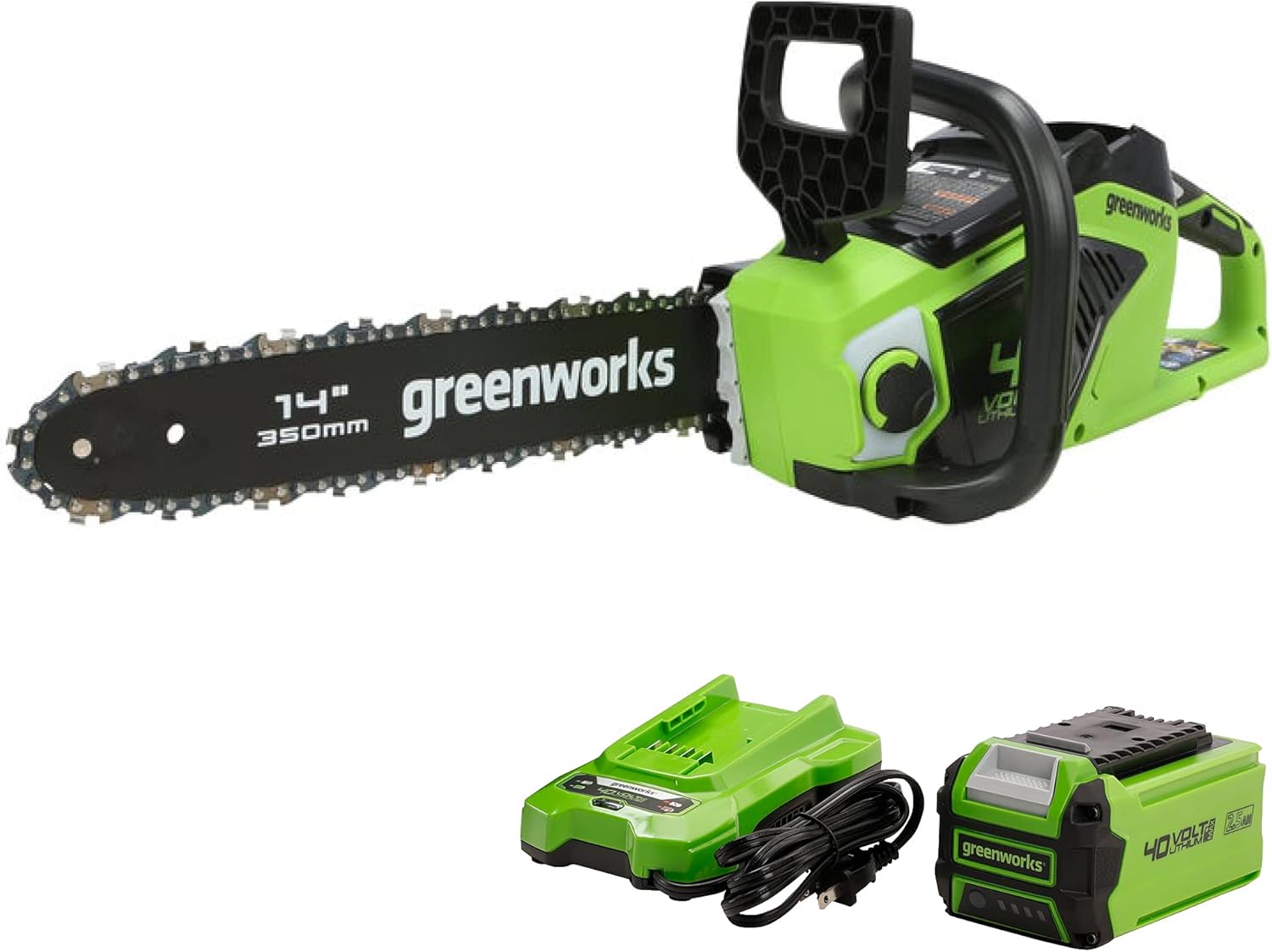
Greenworks 40V 14″ Chainsaw, 2.5Ah USB Battery and Charger Included
Fine Gardening receives a commission for items purchased through links on this site, including Amazon Associates and other affiliate advertising programs.
14” CHAIN AND BAR : great performance for tree cutting and get up to 75 cuts on 4×4 lumber on a single charge. TRUBRUSHLESS MOTOR TECHNOLOGY: 2 x more torque. Provides more power, longer runtimes, quiet operation, and extended motor life. AUTOMATIC OILER: delivers proper chain lubrication and increased productivity. EASY ADJUST TENSIONING: for easy bar and chain maintenance. EASY TO USE : push button start, no gas or fumes, no carburetor, no spark plug, and no starter rope WHAT IS INCLUDED: 40V 14-Inch chainsaw, scabbard, 2.5 Ah batteries, fast charger, operator’s manual.


